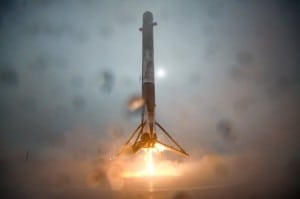Latest News

The first stage of SpaceX’s Falcon 9 rocket used to orbit the Jason 3 satellite nearly completing a landing. Photo: SpaceX
[Via Satellite 01-19-2016] SpaceX launched the joint U.S.-European oceanography satellite Jason 3 on Jan. 17 from Vandenberg Air Force Base in California aboard a Falcon 9 rocket, successfully delivering the satellite to Low Earth Orbit (LEO). The launch company almost landed the first stage on an ocean-faring barge. Following the launch, SpaceX attempted to land the rocket, but said through Twitter that the third of four legs failed to lockout. The rocket landed softly within 1.3 meters of the center of the droneship before toppling over.
NASA reports that the Jason 3 satellite is in good health, having separated from the rocket’s second stage, unfolded its twin sets of solar arrays, and successfully communicated with ground controllers. Jason 3 entered orbit about 15 miles (25 kilometers) below Jason 2. The new spacecraft will gradually raise itself into the same 830-mile (1,336-kilometer) orbit and position itself to follow Jason 2’s ground track, orbiting a couple of minutes behind its predecessor. The two spacecraft will fly in formation, making nearly simultaneous measurements for about six months to allow scientists to precisely calibrate Jason 3’s instruments.
Built by Thales Alenia Space, Jason 3 is an international mission led by the U.S. National Oceanic and Atmospheric Administration (NOAA) in partnership with NASA, the French space agency CNES, and the European Organisation for the Exploitation of Meteorological Satellites (EUMETSAT). During its three-year mission, the satellite will continue what is now almost a quarter-century record of tracking global sea level rise.
Get the latest Via Satellite news!
Subscribe Now